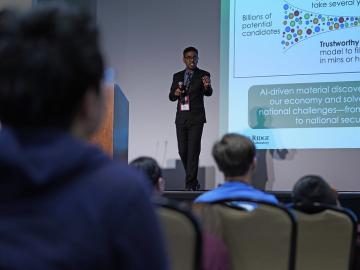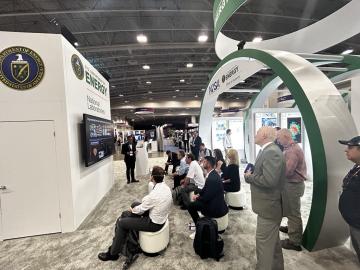
Filter News
Area of Research
- Biology and Environment (65)
- Biology and Soft Matter (1)
- Clean Energy (55)
- Climate and Environmental Systems (1)
- Computational Biology (1)
- Computer Science (1)
- Electricity and Smart Grid (1)
- Fusion and Fission (5)
- Isotopes (2)
- Materials (28)
- Materials for Computing (5)
- National Security (18)
- Neutron Science (14)
- Nuclear Science and Technology (1)
- Quantum information Science (2)
- Supercomputing (39)
News Type
News Topics
- (-) Artificial Intelligence (48)
- (-) Energy Storage (30)
- (-) Environment (105)
- (-) Grid (25)
- (-) Machine Learning (22)
- (-) Microelectronics (3)
- (-) Microscopy (20)
- (-) Nanotechnology (16)
- (-) Polymers (8)
- (-) Space Exploration (12)
- (-) Transportation (27)
- 3-D Printing/Advanced Manufacturing (42)
- Advanced Reactors (8)
- Big Data (27)
- Bioenergy (51)
- Biology (60)
- Biomedical (29)
- Biotechnology (12)
- Buildings (20)
- Chemical Sciences (27)
- Clean Water (14)
- Climate Change (51)
- Composites (8)
- Computer Science (87)
- Coronavirus (17)
- Critical Materials (5)
- Cybersecurity (14)
- Decarbonization (46)
- Education (1)
- Emergency (2)
- Exascale Computing (27)
- Fossil Energy (4)
- Frontier (25)
- Fusion (31)
- High-Performance Computing (45)
- Hydropower (5)
- Isotopes (28)
- ITER (2)
- Materials (44)
- Materials Science (47)
- Mathematics (7)
- Mercury (7)
- Molten Salt (1)
- National Security (42)
- Net Zero (8)
- Neutron Science (49)
- Nuclear Energy (56)
- Partnerships (19)
- Physics (30)
- Quantum Computing (21)
- Quantum Science (31)
- Renewable Energy (1)
- Security (11)
- Simulation (32)
- Software (1)
- Statistics (1)
- Summit (31)
- Sustainable Energy (47)
- Transformational Challenge Reactor (3)
Media Contacts

A study found that beaches with manmade fortifications recover more slowly from hurricanes than natural beaches, losing more sand and vegetation. The researchers used satellite images and light detection and ranging data, or LIDAR, to measure elevation changes and vegetation coverage. Changes in elevation showed how much sand was depleted during the storm and how much sand returned throughout the following year.

At ORNL, a group of scientists used neutron scattering techniques to investigate a relatively new functional material called a Weyl semimetal. These Weyl fermions move very quickly in a material and can carry electrical charge at room temperature. Scientists think that Weyl semimetals, if used in future electronics, could allow electricity to flow more efficiently and enable more energy-efficient computers and other electronic devices.

Two ORNL teams recently completed Cohort 18 of Energy I-Corps, an immersive two-month training program where the scientists define their technology’s value propositions, conduct stakeholder discovery interviews and develop viable market pathways.

Power companies and electric grid developers turn to simulation tools as they attempt to understand how modern equipment will be affected by rapidly unfolding events in a complex grid.

Researchers at the Department of Energy’s Oak Ridge National Laboratory and partner institutions have launched a project to develop an innovative suite of tools that will employ machine learning algorithms for more effective cybersecurity analysis of the U.S. power grid.

In the wet, muddy places where America’s rivers and lands meet the sea, scientists from the Department of Energy’s Oak Ridge National Laboratory are unearthing clues to better understand how these vital landscapes are evolving under climate change.

ORNL's Guang Yang and Andrew Westover have been selected to join the first cohort of DOE’s Advanced Research Projects Agency-Energy Inspiring Generations of New Innovators to Impact Technologies in Energy 2024 program. The program supports early career scientists and engineers in their work to convert disruptive ideas into impactful energy technologies.

Researchers at ORNL and the University of Maine have designed and 3D-printed a single-piece, recyclable natural-material floor panel tested to be strong enough to replace construction materials like steel.

Prasanna Balaprakash, a national leader in artificial intelligence, or AI, spoke to some of the highest achieving students in the country at the National Science Bowl in Washington D.C.

ORNL researchers and communications specialists took part in the inaugural AI Expo for National Competitiveness in Washington D.C, May 7 and 8, to showcase and provide insight into how the lab is leading the way for utilizing the vast possibilities of AI.


